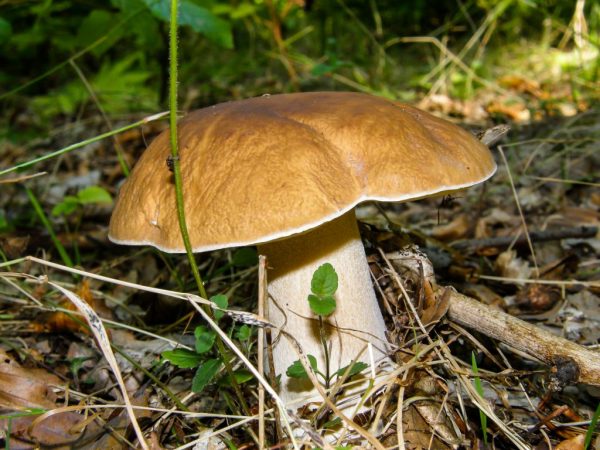Butcher mushrooms and their varieties
Mushrooms belong to the Boletov family and are characterized by the so-called. porous, and scientifically correct - a tubular hymenophore. This family includes boletus and aspen mushrooms.

Mushrooms and their varieties
general characteristics
According to the description, the mushrooms have a large mushroom cap. Its surface can be both smooth and felt or velvety, without shine, matte. The color is usually brownish-red.
The hymenophore in representatives of the genus Leccinum or Obabok is tubular in structure, easily separates from the lower surface of the mushroom cap. The tubes forming the hymenophore reach a length of 1.5 cm, finely porous, closer to white in color, with a gray or yellow tint, darken as the fungus grows.
The mushroom mushroom is a classic representative of Basidiomycetes, producing fungal spores in Basidia.
The mushroom leg has the shape of a cylinder; in some representatives, the lower part is thickened. The surface of the leg is usually covered with scales.
Mushrooms are one of the most valuable edible mushrooms. They are not used in their raw form; first, you need to subject them to heat treatment.
Geography of distribution
All representatives of the stump group form a symbiotic association of the mycelium with the roots of deciduous trees, but not with conifers. And to put it simply, they form mycorrhiza with the roots of representatives of various deciduous trees.
According to the description, representatives of the Obabok genus are widespread in zones with a temperate climate, found in a number of subtropics and areas with a subpolar climate.
Most of the mushrooms grow in the temperate latitudes of the Northern Hemisphere.
Varieties
Boletus

The dump has a poisonous twin
The fruiting period of boletus starts from the end of May and lasts until the last days of October.
Edible varieties:
- Common boletus, or birch, or blackhead: cap with a diameter of 5-15 cm, color from gray to brown-brown, changes depending on the weather, mushroom pulp is dense, but at the same time watery, grows in birch and mixed forests, fruiting period - end of May - October.
- Boletus gray, or grabovik: a hat with a diameter of 6-20 cm, the color is brown-gray, the mushroom pulp is cotton-like, it acquires a purple hue on the cut, grows in broad-leaved forest strips from July to September.
- Boletus black: the cap is 5-20 cm in diameter, the color is black-brown, the mushroom pulp is dense, elastic, with a sweetish taste, grows in wetlands (the edges of raised bogs) in forests with birch, the fruiting period is July-September.
- Pink boletus: the cap is 8-18 cm in diameter, the color is brownish-gray, the mushroom pulp is fibrous, changes color to pinkish on the cut, grows in damp birch forests and pine-birch forest strips, the fruiting period is July-October.
- White boletus, or marsh boletus: the diameter of the cap is 4-15 cm, the color is off-white, the mushroom flesh is watery, the white color does not change on the cut, but sometimes it turns blue, the taste is fresh, the smell is weak, it grows in birch forests and mixed forests near swamps, the fruiting period is the second half July-October.
The edible boletus (boletus) has a false counterpart, called a bile mushroom, and is distinguished by the pronounced bitterness inherent in the pulp.
Aspen boletus
Mushroom appearance time:
- in the last days of June, but the harvest is not abundant, such mushrooms are called spikelets;
- stubble forests grow massively in mid-July;
- deciduous trees appear in large numbers from the end of August to the end of September.
In the wet summer season, single fruiting is observed between the growth stages of boletus boletus.
Common edible varieties:
- Red boletus, or redhead: a hat with a diameter of 5-20 cm, the color depends on the place of growth: in poplar forests it has a gray tint, in aspen - dark red, in mixed - orange-red. The fruiting period is from June to October.
- Boletus white: the cap is 4-20 cm in diameter, the color is light brown, the mushroom pulp is firm, turns blue on the cut, grows in aspen and mixed forests, the fruiting period is June-September. By the way. White boletus is a rather rare mushroom. It is included in the Red Book of Russia. This species is often considered a variety of wild boletus (yellow-brown).
- Boletus boletus: cap with a diameter of 8-20 cm, red-brown color. The pulp is dense, turns black on the cut, grows in dry places among mosses, the fruiting period is June-September.
Irina Selyutina (Biologist):
In a young boletus, the cap tightly fits the upper part of the leg - it actually squeezes, resembling a thimble put on a finger. But as it grows, the cap flattens out and in mature specimens it has the usual shape for us. But for overgrown specimens, its almost flat shape is characteristic.
Very often, novice mushroom pickers confuse boletus and aspen mushrooms. To prevent this from happening, make a small incision on the fruiting body of the mushroom: if the initially white pulp turns blue, and then turns black, there is a boletus in front of you.
Since the species of both boletus and boletus differ little outwardly, mushroom pickers generally call them boletus. But each species has its own specific characteristics and experienced mushroom pickers know about it. Knowledge of the so-called can be especially helpful. an ecological characteristic of the species, which will allow you to always bring home a full basket of wonderful edible mushrooms.
The boletus has a false conditionally edible counterpart called bitterness, it is also a gall mushroom, which contains a characteristic bitterness.
Conclusion
The mushroom is edible in most cases and is widely used in cooking. The genus includes a number of related species - boletus and boletus boletus, which are very similar in appearance. They have false edible counterparts.



